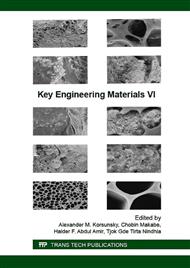[1]
Yan Xinping, Li Zhixiong, Liu Zhenglin,, Yang Zhongmin, Yang Ping, Zhu Hanhua, a review of the research on the dynamics of large ship propulsion systems and ship hull, ship mechanics, 2013, (4): 439-449.
Google Scholar
[2]
Zhang Lei, Wang Wei, Feng Zhoupeng, Zhang society, the function of metal/ceramic gradient thermal barrier coating material system and preparation method of [J] hot working technology, 2010, (26): 99-103.
Google Scholar
[3]
Tang Dapei, Gao Qing, Jiang Xiaoyu, metal ceramic gradient thermal barrier coating [J] functional materials, 2004, (35): 1713-1717.
Google Scholar
[4]
Wang Xuebing, Zhang Xinghong, Du Shanyi, [J] of gradient thermal barrier coatings, China surface engineering, 2004, (3): 5-8.
Google Scholar
[5]
Nie Ronghua, Jiao Guiqiong, Wang Bo, C/, 2D braided SiC ceramic matrix composites, thermal conductivity prediction [J], composite materials, 2009, (13): 169-174.
Google Scholar
[6]
Zhang Tianyou; Wu Chao; Zhou Shengfeng, Xiong Zheng; research progress of thermal barrier coating material and preparation technology of [J] Laser & Optoelectronics Progress, 2014, (3), 1-6.
DOI: 10.3788/lop51.030004
Google Scholar
[7]
R. Wesley Jackson, Matthew R. Begley, Critical cooling rates to avoid transient-driven cracking in thermal barrier coating (TBC) systems [J], International Journal of Solids and Structures, 2014, Vol. 51, No. 6: 1364-1374.
DOI: 10.1016/j.ijsolstr.2013.12.029
Google Scholar
[8]
Guo Hongbo, Gong Shengkai, Xu Huibin, [j], gradient thermal barrier coatings of aircraft, 2013, (5): 467-472.
Google Scholar
[9]
M L Mendelson, T N Mckechnie, L B Spiegel. Graded thermal barriercoatings: evaluation [J]. Ceramic Engineering and Science Proceedings, 2008, 15(4): 555-562.
Google Scholar


